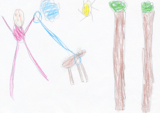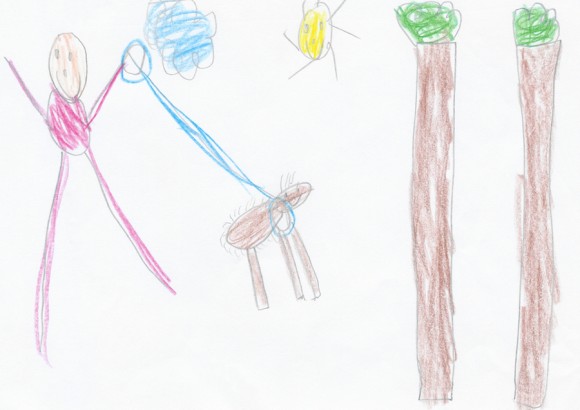Helping Kids with the Death of a Pet
An interview with Lauren Rosenfeld M.A., M.Ed.
I remember the exact moment I found out that our family pet, Toto, had died. I was just eight-years-old at the time, but the sadness was nearly unbearable and I was inconsolable. As my mom struggled to find the right words to comfort me, all I wanted to know was were my dog went – not her body, but the life inside her. Tough stuff to explain to a child. Now I find myself going through the same struggle, albeit on a smaller level. Our pet zebra finch, Birdie Bird, just passed away and our four year-old had many concerns. Where are we going to put her? How will we know if she is okay? When can we get another bird? Our expert Lauren Rosenfeld helps us field the difficult questions that come from losing a cherished family pet. – Christina Montoya Fiedler, TMC Contributor
How can having a pet help a child develop socially or emotionally?
A family pet is more than just a friend: a pet is a family member, an integral part of the family unit and its unique dynamic, loving and beloved – a part of our families’ stories and histories. And this is especially true for children. When we brought home our dachshund Bingo at eight weeks old, our youngest daughter was just ten months old and crawling. Since she was a late walker, the two of them – the baby and the puppy – were on all fours together for months. Bingo treated Tamar like a littermate and Tamar thought of Bingo as a sibling. Even up until the end of his life when they were both twelve years old, they spent a significant amount of time every day playfully rolling on the floor together. Their relationship was loving and intuitive and their bond deep.
Pets teach children all about love, compassion, and care. They teach children how to be gentle and caring – they learn that genuine, gentle affection is lovingly reciprocated; they learn how much play is too much or too rough. Pets teach children how to be respectful of personal space. Through non-verbal communication, they teach children how to intuitively watch for signs of hunger or discomfort. They teach children how to take responsibility for another living, breathing being who is dependent. They teach them about unconditional love and undying affection. And at the end of a pet’s life, a pet can teach a child how to let go, how to say goodbye with courage and grace, and how eternal love really is.
If a pet is dying, how do parents explain the situation to their kids?
Children understand illness. They have felt it. They have been through it. They have had pain and fevers, coughs, sniffles, headaches, broken bones. They understand that being alive means being vulnerable to feeling bad, being in pain, or being weak. How much you share about a pet’s illness depends upon how much a child understands about illness in general –about what it feels like for them to be ill. For a very young child, we might just say, “Freckles isn’t feeling well. His tummy hurts. You know how when your tummy hurts and you just want to sit on the couch and you don’t feel like playing. That is how he feels right now. Do you want to give him a gentle pat and then let him rest?” If a child is older it may feel comfortable to you to discuss a pet’s declining health in terms of aging. It’s important for children to understand that pets age faster than we do – so even though they may just be teenagers in human years, they are quite elderly in pet years. Even when an senior pet is relatively healthy but beginning to show signs of aging, it is good to remind the child in a gentle way that that aging animals – like aging humans — can develop health problems. Sometimes pets seem ageless, and it can be a shock for children when they go into rapid decline.
I would say as a general rule, don’t tell a child more about a pet’s illness than they are able to comprehend about a human illness.
When a pet dies, how can we best help a child to navigate his or her emotions around the loss?
Don’t feel like you need to protect your child from the fact of illness, death or injury. All living beings are prone to illness, are vulnerable to injury, and will ultimately die. Nature itself gives us plenty of opportunity to reflect on this reality: leaves that dry up and fall off trees, flies that find themselves trapped in spider webs, flowers petals that lose their color drop. Of course the fact of it can feel sad, but we shouldn’t be afraid of their sadness. We can’t protect our children from sadness or loss. Nor should we. It is a part of life and if we allow our children to feel through their feelings without pushing them away, they will learn to cope with sadness early and well.
What kind of reactions might we expect from our grieving child? Are there any reactions that should raise red flags?
I think the best thing we can do is allow them to have their feelings. Children are naturally comfortable with their feelings. Unfortunately we parents feel uncomfortable with our children’s sadness. We don’t want our children to suffer, so we try to jump in and bring it to an end. We want to cheer them up because we find their sadness to be hard to bear. But sadness and grief must take their course. We can help the process along, but we can’t decide externally when and how it will come to a conclusion. We should not fool ourselves into believing that our child can be distracted from the pain of their loss by the offer of an ice cream or the joy of a bike ride, or even the excitement of a new pet. Sadness has to be felt and then released by the person who is feeling it. We can encourage a child to express their sadness – through talking, through art, through creation of a loving memorial – but we ourselves cannot preempt it.
If parents are mourning too, how should they best model their grieving?
Losing a beloved pet can be hard for us, too. It’s important for our children to know that as well. It’s okay to tell them we are sad and why. It’s okay for them to see us cry. And in many ways its instructive to them and important role modeling about how all humans feel when they experience a loss. What is important is for the child to know that though they may offer compassionate feelings for you, they are not responsible for making you feel better, or holding you up. When a child feels like they have to be strong for you, they are likely to try to protect you from their feelings. They may hide their feelings because they don’t want the loss to be harder for you. And if they do that, they are not going to process their feelings or get the emotional support they need from you.
Should the family get a new pet? If so, what’s the best timing to introduce a new pet?
If there is not already another pet in the house, it is a good idea to wait for a child to go through their grieving process before bringing a new pet into the house. Trying to “fix” the situation by filling an empty space in the home and in the heart with a new pet is unfair to both the child and the pet. For the child, in your attempt to cheer them up, you are short-circuiting the grieving process. The child may think of the new pet as simply a replacement (and what animal could truly replace the pet they just lost?) and may not want to bond with the new pet. And in the end, this can be unfair to the pet, who genuinely deserves the kind of unconditional, loving bond only a child can offer.
Lauren Rosenfeld, M.A., M.Ed., is a mother of four children, ages 12 through 16. She has been an educator for over 25 years, is a parenting coach, and is the co-author of Your To Be List: Turn Those Dreaded To-Do’s into Meaningful Moments Every Day! and the upcoming book Breathing Room: The Spiritual Guide to Decluttering Your Home and Your Heart.
The Mother Company aims to support parents and their children, providing thought-provoking web content and products based in social and emotional learning for children ages 3-6. Check out episodes of our “Ruby’s Studio” children’s video series, along with our beautiful children’s books, apps, music, handmade dolls, and more.

